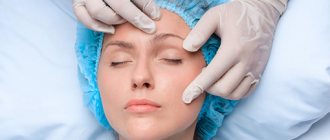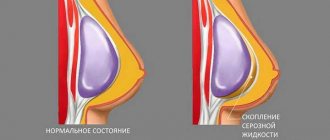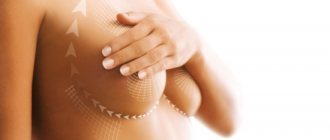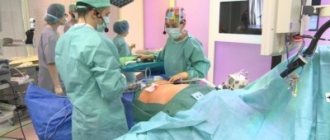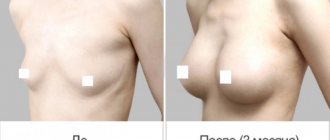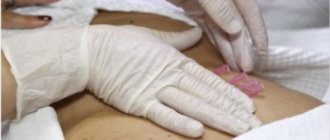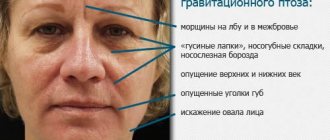Mammoplasty or breast surgery is one of the most popular and sought after operations.
- Why complications arise
- Types of complications Swelling of the chest or abdomen
- Seromas and hematomas
- Increased body temperature and inflammation
- Pain after mammoplasty
- Keloid scars
- Loss of skin sensitivity
- Capsular contracture
- Damage to the implant
- Breast deformities and their unnatural appearance
Every year, many women come to surgeons wanting to make their bust bigger. Intervention techniques, as well as the implants used, are constantly being improved. However, mammoplasty remains a full-fledged operation, after which, theoretically, complications may arise, especially if the patient ignores the recommendations of doctors during the rehabilitation period.
Loss of sensitivity of the nipple and areola
Minor sensory disturbances may be associated with edema. The swelling will subside and sensitivity will be restored.
Mammoplasty allows you to achieve the desired size and shape of the breast.
However, there are complications that patients should be warned about when deciding to undergo this intervention.
These include: impaired sensitivity of the areola and nipple, purulent infections, seromas, hematomas, tissue necrosis, breast numbness, skin ripples, symmastia, capsular contracture, ruptures, displacement and deformation of the implant.
Most often, the sensitivity of the nipple and areola is not affected by submarinal (under the breast) and axillary access. It is disrupted with periariolar access (the border of the areola and the skin on the chest).
Infection
Any operation is associated with infection. The first factor is the qualifications of the surgeon and his professional work experience. The second factor is the patient’s failure to comply with hygiene requirements after surgery.
A lump in the breast that appears after mammoplasty can be mistaken for signs of mastopathy.
This disease is diagnosed only after examination by a specialist and examination. After the procedure, it is eliminated by changing the implant if discomfort and pain appear in the chest.
Cosmetologist, dermatologist, trichologist
Kalinina Olga Alexandrovna
4 years of experience
Accompanied by a temperature above 38 degrees, redness and purulent discharge. Antibiotics and antiseptic drugs are prescribed, and in difficult cases, the endoprosthesis is removed or replaced.
Seroma and hematoma
It is normal for a small amount of fluid to collect around the breast prosthesis, but seroma after mammoplasty is a lot of clear serous fluid.
The more extensive the surgery, the more likely it is that seromas will appear. If the gray is left unattended, it can persist for a long time and cause hardening. Surgically removed using a syringe.
Any irritant can cause gray matter:
- reaction to the prosthesis when the capsule has not yet formed;
- physical activity, injuries;
- early refusal to wear compression garments;
- failure to comply with the recovery period.
Repeated mammoplasty
Repeated mammoplasty is a surgical intervention that is performed when the desired result is not achieved after the first procedure or due to loss of shape of the mammary glands over time.
To prevent seroma formation, you should wear compression garments for at least 6 weeks.
A hematoma is a collection of clots of dried blood in sacs around a breast implant. It is accompanied by severe swelling, fever, and inhibits muscle mobility. Treatment of the hematoma is mandatory.
When should you see a doctor?
Once the swelling subsides, there should be no remaining discomfort. However, if pain in the area of the sutures or nipples persists, especially if it lasts more than two weeks after the operation, this is a reason to visit a doctor. Another reason to visit a surgeon arises if the chest area is painful to touch, hematomas appear or do not go away, and general changes in the condition of the body are observed. A change in skin color is also not the best sign: perhaps an inflammatory process has begun. In order to prevent the development of dangerous side effects, choose trusted clinics and experienced doctors. The use of high-quality materials that have undergone clinical research allows us to avoid such unpleasant consequences of mammoplasty.
To make an initial consultation with a Bust Clinic specialist, just call us at the specified phone number or use the convenient feedback form. Our administrator will contact you shortly and help you choose the optimal appointment day.
Scarring
Immediately after the operation, the surgeon applies a special plaster to the scar. It makes it possible to maintain body hygiene at first.
It is important to allow scars and cicatrices to heal quietly in the first months. Surgeons recommend:
- do not scratch the scar, but let it heal and form;
- smear the formed scar with a special silicone gel;
- stick on silicone strips, which allow the skin to breathe and do not allow water to pass through, and also visually make the scar invisible;
- do not visit swimming pools, postpone a trip to the sea;
- do not load the chest area, scars should not stretch.
Compression garments after mammoplasty
Mammoplasty is a surgical intervention, so the patient needs a rehabilitation period.
After a few months, the incision line will not be visible at all. But if a woman’s visible part has an unaesthetic appearance and this bothers her, plastic surgery has ways to correct this:
- excision of a scar or scar;
- grinding.
There cannot be the same time period until complete recovery. Therefore, if the scar is red, you need to wait until it turns white. Otherwise, you can get a keloid.
Breast change
After surgery, breasts may change shape and become denser. This change is called capsular contracture.
Essentially, a capsule of fibrous connective tissue is formed around the implant, which thickens and thickens over time. Normally, the capsule is very thin and measures 1/10 of a millimeter. But with capsular contracture, the capsule grows to 2-3 mm or more.
Why can our articles be trusted?
We make health information clear, accessible and relevant.
- All articles are checked by practicing doctors.
- We take scientific literature and the latest research as a basis.
- We publish detailed articles that answer all questions.
It gradually squeezes and compresses the implant, which leads to its deformation, and therefore to a change in the shape of the breast and to pain. In severe situations, it leads to atrophic changes in breast tissue.
If capsular contracture is detected, corrective surgery is performed. The implant is changed and the capsule is removed.
Possible complications associated with implants
A capsule is formed around the breast implant. Capsular contracture is more common with silicone implants. Capsular contracture, consisting of fibrous tissue, begins to compact the implant, which leads to pain. The aesthetic appearance of the breast also deteriorates.
Surgery for severe capsular contracture allows removal of the capsule itself and the endoprosthesis. Mild cases do not require surgery.
Implant rupture
High quality implants undergo many stages of testing at factories, which indicates their safety. They are filled with state-of-the-art cohesive gel and come with a lifetime warranty. Even if the implant ruptures, the gel will not leak into the soft tissues and will not harm the patient’s health.
Implant rupture may not be visually noticeable. But it is detected on a mammogram or MRI.
Severe tears can ruin the appearance of the breasts and cause inflammation, swelling and pain.
Deformation of the endoprosthesis
If after mammoplasty one breast has become larger than the other, this will disappear in the first months after the operation, when the swelling goes down.
Augmentation mammoplasty
Augmentation mammoplasty is a type of plastic surgery to enlarge the breast and correct its shape.
In another case - with an incorrectly selected endoprosthesis or placement.
In the third case, deformation may have occurred:
- Saline are more susceptible to deformation .
- What matters is volume of the implant: normal and overfilled. When overcrowded, there is less wrinkling.
- Textured endoprostheses are more deformed and wrinkled than smooth ones.
- Implants “under the muscle” are deformed to a lesser extent.
- The double-bubble can also be classified as a special type of deformation .
Implant displacement
It takes time for a breast implant to become firmly entrenched in the tissues. To do this, immediately after the operation the patient is dressed in compression garments. To avoid asymmetry and displacement, it is recommended to completely avoid physical and strength loads on the chest and upper abdomen for three months.
If after three months adjustment is still needed, additional procedures are prescribed.
A loose pectoral muscle may cause discomfort during the postoperative period, but this goes away over time as the muscle and implant adjust to each other.
Breast implants
Breast implants are shells made of silicone, which contain a water-salt solution or a special gel filler.
Saline implants are more likely to dislodge because they are heavier than silicone ones.
An implant that is placed above the muscle is more susceptible to displacement than an implant that is placed under the muscle.
Possible consequences of mammoplasty after a few years or months
Cracks and ruptures of implants
Leading manufacturers produce models with a three-layer surface and a biocompatible filler resembling marmalade, so if the endoprostheses rupture, they do not harm the breast tissue.
If there is saline solution inside the shell, it will flow out quickly. The liquid does not pose a health risk, but the shape is completely deformed.
Whether the breast is severely deteriorated or not, in any case, the damaged implant must be replaced.
Capsular contracture
When a foreign body is implanted, the body tissues form a kind of capsule around it. The implant can change shape under such pressure. The causes of excessive growth of connective tissues are infections, improper preparation of the endoprosthesis, intense physical activity, and the predisposition of the woman’s body.
There are 4 degrees of capsular contracture:
- Externally and to the touch, the breast does not differ from healthy breasts; pathology can only be detected instrumentally.
- If external signs remain unchanged, the endoprosthesis can be felt by palpation.
- Firm breasts, slight deformation possible.
- Obvious deformation, the mammary gland is cold and hard.
Doctors believe that complications after mammoplasty that require treatment are caused by 3rd and 4th degree contractures.
The risk of unpleasant consequences is reduced by installing implants with a rough (textured) surface.
Calcification
The peculiarity of the body is expressed in the intense release of calcium salts in certain areas around the endoprosthesis. Pathology can be detected by palpation and visually. Severe deformation disrupts the aesthetic appearance of the bust and requires correction.
It is impossible to foresee complications of this nature before breast augmentation.
Necrosis after mammoplasty
Breast numbness can be caused by insufficient blood supply to the tissue under the pressure of the implants. More common causes of cell death are steroid use, smoking, excessive drinking, and injury to nerve endings during surgery.
Contouring of the implant under the epidermis layer
The complication is a consequence of an insufficient layer of subcutaneous fat and can appear almost immediately after the introduction of endoprostheses in slender girls with small glands or after losing weight. Also, under the weight of the implant, it is possible that the veins in the chest will expand.
To correct the problem, lipofilling is done or fillers are injected.
Waterfall effect
With this complication, the implant is visually separated from the breast and forms a double fold. This pathology does not disrupt physiological processes, but is a serious cosmetic defect, which over time causes depression in the patient.
The complication can appear either a couple of months after mammoplasty or several years later. In most cases, surgical intervention is necessary to correct the defect.
Implant displacement
There are several reasons for the complication:
- Breast plastic surgery performed with violations: the size of the endoprosthesis is too large, the wrong location, ignoring the rules for forming a pocket. Implantation through the armpit carries a greater risk of complications.
- Calcification or intense growth of fibrous tissue.
- Violation of the rules of the postoperative period.
Scars
Small marks will remain after breast surgery, but will be practically invisible even upon visual examination. The main thing is to use silicone pads and compression garments. Scar cream should be used only after their final formation.
If the skin is prone to the formation of keloid scars, mammoplasty will be unsuccessful, so it is better to use other methods to correct the glands.
Unnatural breast appearance
If you choose the right implant, problems of this nature do not arise. But women sometimes lose their sense of proportion and choose endoprostheses that are too large. The implantation of such an implant into an initially miniature bust gives it away, and the mammary glands look unnatural. Also, due to the weight of the implant, the veins in the chest may expand.
Plastic surgery does not cause the formation of tumors, but it reduces the possibility of obtaining reliable results with mammography. As a result, a benign tumor that is not diagnosed at an early stage gets enough time to transform into a malignant one.
Double fold (or double bubble)
Double bubble after mammoplasty is a serious aesthetic complication. The chest does not look like a single whole, but as if folded.
30% of women have a specific anatomical feature of Cooper's connective tissue ligaments. These ligaments are located under the breast and support the weight of the entire glandular part. After surgery, when swelling goes down, a small percentage of women face this problem. Surgeons offer correction.
During correction, an incision is made, part of the breast tissue is excised, carefully straightened and fixed in a new place to a new submammary fold.
The double fold after mammoplasty will still be noticeable for some time, but after a week this deformation will disappear. Patients after such correction must wear compression garments for two weeks.
Calcification
This is a specific complication of breast surgery, which is associated with the individual characteristics of the body. The mammary gland becomes deformed and its aesthetic appearance is lost.
A deposit of calcium salts forms around the implant - calcification. During examination and palpation, the surgeon identifies foci of calcification and may suggest implant replacement or correction surgery.
There is no prevention for this complication.
These deposits may be mistaken for tumors on mammography.
Photo
Next in the photo you can see what complications look like as a result of a non-professional lift - breast plastic surgery before and immediately after surgery: deformation of the mammary glands, one breast is higher, the other is lower, etc. (read more about when a breast lift is done, what types it is and how the procedure is performed here).
Symmastia
This is an aesthetic complication after mammoplasty, in which the implants are located very close to each other. Visually, the mammary glands seem to have “grown together.”
The reason may be:
- choosing breast implants voluminous
- anatomical location of the mammary glands.
To avoid symmastia, an experienced surgeon must select the correct size of the breast implant, otherwise you will have to make a correction with smaller implants.
Hormonal disbalance
Why do breasts itch before menstruation? Because this is a normal reaction of the organs of the woman’s reproductive system, including the mammary glands, to an increase in the quantitative composition of estrogen in the blood. All symptoms disappear immediately after menstruation ends.
The worst option may be burning and itching, which arise as a result of disturbances in the activity of the ovaries and endocrine glands.
Reduced efficiency of breast cancer diagnosis
Breast implants and silicone have not been proven to cause cancer. Patients who have had a gland removed due to cancer are fitted with endoprostheses.
Sometimes it happens that a patient came for mammoplasty and an oncological disease was detected.
Experienced surgeons sometimes combine operations: during mammoplasty, for example, fibroadenoma is removed. And the removed material is sent for further examination.
Nipple correction
Correction of nipples and areolas is a type of plastic surgery that changes the shape, contours and size.
Endoprostheses make mammography examinations more difficult, which reduces the effectiveness of diagnosing cancer.
To prevent implant rupture during palpation and examination, it is necessary to warn the doctor about its presence.
Angelina Jolie is not the first
June 22, 7:27
“We are not cutters”: a plastic surgeon - about the request “like Jolie” and the difference in price
Why going to Moscow for new breasts is no longer relevant, what are the features of male plastic surgery and what you definitely won’t be able to change about yourself
About 10 years ago, Angelina Jolie had her breasts removed and implants inserted for preventive purposes - she had a very high risk of developing cancer. This operation - subcutaneous mastectomy - has been performed in Barnaul for several years now.
“Angelina Jolie once drove everyone crazy with this operation. In fact, she was not the first. For example, in Barnaul such operations have been performed for more than 20 years,” the specialist commented.
Such operations are performed for certain indications: a high risk of inherited cancer, the presence of multiple benign tumors, and even treated distant cancer in the adjacent breast.
“There are times when a patient, who has already had one breast removed due to cancer, asks to have the second one removed out of fear. This puts a lot of moral pressure, and women want to play it safe,” explains the doctor.
We do not perform such operations free of charge within the framework of compulsory medical insurance.
Decreased ability to breastfeed
Breastfeeding issues are discussed with the surgeon in the preparatory period. Both saline and silicone endoprostheses do not have a negative effect on pregnancy and fetal development, even in the event of rupture.
With periariolar access (through the isola incision), the ability to breastfeed is significantly reduced or completely lost, as the ducts are crossed.
With submarinal (under the breast) and axillary access, the mammary gland is not injured. But if there were complications, the risk of impaired ability to breastfeed remains.
After breastfeeding, at least 6 months later, you can begin preparing for mammoplasty.
How long do breasts hurt after mammoplasty?
Pain after mammoplasty is normal. The tissues gradually begin to heal and return to normal. If your chest has been hurting for too long, then this is a reason to consult a surgeon.
Some women complain that their back hurts. Most surgeons consider this reaction of the body as normal. After some time, the soreness should go away.
A burning sensation in the breast after mammoplasty may also be normal, but it is better not to risk it and see a doctor.
Plastic surgery has come a long way. Complications after surgery are quite rare if the procedure was performed by a qualified specialist. But no one is immune from failure. If the number of unpleasant symptoms after the procedure begins to increase, you need to contact your doctor again.
For some time after mammoplasty, the breasts occupy a position that is too high, uncharacteristic for a normal bust. Gradually the chest lowers and takes the correct position. When the breasts sag, they take on a natural appearance.
There is no need to panic if one mammary gland has dropped before the other. This happens, and this is a normal process. But, if the second mammary gland does not descend for a long period of time, then you should consult a surgeon.
Capsular contracture
In medicine, capsular contracture is a formation that consists of dense fibrous tissue. It forms around the implanted implant, gradually squeezing it. But it is a normal reaction of the body to a foreign body.
But you should consult a doctor when signs of capsular contracture begin to bother you. Among them, hardening of the neoplasm and its increase in size are noted.
The causes of contracture formation are:
- Accumulation of serous fluid around the implant, which leads to its detachment.
- Inflammation.
- Failure to comply recommendations during the rehabilitation period.
- Hematomas formed after surgery.
- Incorrect implant size.
- Silicone gets between the implant and fibrous formation as a result of rupture of the first.
Sex after mammoplasty
Mammoplasty is a surgical operation aimed at changing the shape and size of the mammary glands.
In cases where the capsular contracture is large, repeated surgery is performed to remove it.
In order to prevent the development of such a complication, it is necessary to follow all the specialist’s recommendations during the rehabilitation period, use implants with a textured surface, wear special compression garments and regularly visit a specialist.
If your chest itches or there is a lump in the area where the implant is located, you should consult a doctor.
What to do for prevention to reduce the risk of developing consequences?
In order to avoid problems after mammoplasty, you should carefully follow all the doctor’s instructions.
Also, to prevent complications after breast augmentation, you must do the following:
- Massage is performed only as prescribed by a doctor. It can be prescribed some time after the intervention. All manipulations that need to be performed must be demonstrated by a qualified specialist.
- Skin care – the use of special cosmetics. This method will help avoid the appearance of stretch marks and sagging breast skin years after breast surgery.
- Weight control . It is important to strictly monitor your diet, as weight changes can lead to unpredictable consequences.
- Compression garments must be worn throughout the rehabilitation period. In the future, it is recommended to purchase high-quality and comfortable underwear.
Beautiful and firm breasts are one of the main advantages of the fair half of humanity. For those who for some reason are deprived of this dignity, the dream breast becomes goal number one. To achieve what they want, women are ready to go to great lengths, and even go under the knife. Fortunately, modern surgery has come a long way, and doing mammoplasty today is no worse than having your appendix removed .
For a successful operation and a good result for many years, you need to carefully prepare, take a responsible approach to choosing a clinic and specialist, and also follow all instructions during the rehabilitation period.
You may be interested in reading our other materials about how reduction and augmentation mammoplasty, as well as nipple and areola correction surgery, are performed.
Pain
Often after mammoplasty, patients complain that their breasts hurt. Unpleasant sensations occur for 2-3 days after surgery, provided the healing process is normal and all doctor’s recommendations are followed. But you should know that the duration of the recovery period is individual in each case.
After mammoplasty, the nipples may hurt, which is also not a deviation, provided that the pain does not increase, but gradually disappears.
The causes of pain are injury to soft tissues during surgery and their stretching during the recovery period.
How long does the discomfort last?
We have already said how long the swelling lasts after surgery, but the discomfort may lie in other symptoms. This is pain, discomfort and a host of other subjective problems. The duration of rehabilitation varies depending on the recovery abilities of the body of each individual patient, careful adherence to the surgeon’s recommendations and a number of other factors. On average, any discomfort disappears after about two months: it is during this time that swelling disappears without a trace. To help the body recover, you will have to strictly follow all the doctor’s prescriptions and regularly appear for examination. If the discomfort does not go away for more than two months, this is a reason to immediately go to the surgeon and inform him about it. Otherwise, complications may occur that will lead to displacement of the implants and loss of aesthetics.
Swelling of the abdomen
Swelling is a normal reaction of the body to surgery.
Sutures after mammoplasty
Suturing after mammoplasty is a standard final surgical procedure.
But abdominal swelling after mammoplasty is not observed in all patients. Often, an unpleasant symptom occurs when access during surgery is carried out under the breast.
It appears gradually. Swelling immediately after a breast augmentation procedure is observed only in the mammary glands. After 1-3 days it drops onto its stomach. In appearance, it is swollen; when pressed, marks may remain.
The color of the skin changes only when there is bleeding. In this case, bruises and hematomas appear on the abdomen.
Unsuccessful breast surgery can lead to swelling. In this case, the symptoms will be pronounced, they will constantly increase and worsen.
To relieve swelling, it is recommended to apply cold to the abdomen, wear compression garments after surgery, and eat right. In the first days after surgery, you should not take a hot bath, shower, or visit a sauna or bathhouse. In severe cases, it is necessary to use homeopathic remedies in the form of creams to relieve swelling.
Consequences of breast augmentation that may occur immediately after the procedure
In some patients, postoperative symptoms appear immediately after the operation and gradually disappear, or they remain and require correction. For others, the side effects of plastic surgery are noticeable only over time. What symptoms may occur?
Hematomas
Internal bleeding appears from an unsutured vessel or after restoration of circulation in the area where the blood has clotted during the invasion.
A hematoma can be identified by a brown clot under the skin and tissue compaction in this place. In some cases, breast deformation is possible. The problem is corrected by cutting and clearing out the blood clots.
Edema
This is a normal condition that occurs due to tissue injury. Swelling is a problem only if it does not go away within 2 weeks and the abdomen is swollen (enlarged). The reason is non-compliance with rehabilitation rules: refusal to wear compression stockings, early physical activity, sun and thermal treatments.
In some cases, swelling is an allergic reaction if the preliminary examination before breast augmentation was not carried out properly.
Suppuration and itching
Symptoms indicate an inflammatory process. It begins when bacteria enter the wound during surgery, during the rehabilitation period, or when an implant is rejected. The patient has a high fever, back pain, chest pain at rest, and nipples do not heal for a long time.
The cause is eliminated by drainage, lavage and antibiotic therapy. If the procedure is unsuccessful, the endoprosthesis is removed.
Pain
This is a common discomfort after surgery: the nipples hurt, there is shooting in the chest and the glands are bursting. The pain gradually subsides, then disappears completely. If at the same time the patient does not develop a lump in the chest muscle, chills, discoloration of the skin, or a rash, then the symptoms do not cause concern to doctors. On average, the rehabilitation period lasts 2 months.
Seroma
Fluid accumulation under the implant may appear on one or both sides of the breasts. At the same time, the breasts increase unnaturally in size. The pathology is determined by ultrasound, and the serous fluid is removed with a syringe.
Asymmetry
It is impossible to predict how breast tissue will behave. The endoprosthesis can move under the action of muscles. In some cases, atheroma forms in the mammary gland. Rarely, the cause of asymmetry is a pocket formed incorrectly by the surgeon inside the breast for implant installation.
Allergy
If the breasts are very itchy after mammoplasty , this may indicate incompatibility of the prosthesis material with the tissues of the mammary gland. Typically, a possible complication is identified during a preliminary examination, but “gaps” cannot be excluded. And a woman does not always listen to the surgeon’s advice.
Loss of dermal elasticity and mastoptosis
Pathology more often occurs in women if their breasts had stretch marks or sagged before mammoplasty. Other options are not excluded, especially if the implant is installed not under a large muscle, but under a gland.
There are 2 ways to eliminate the consequences of breast enlargement: installing a larger endoprosthesis or tightening the skin, and then returning the original model.
Loss of sensation in the dermis
The complication is usually temporary and goes away six months after breast enlargement.
Pathology occurs due to damage to the nerve fibers that go to the skin. Typically, doctors diagnose a lack of sensitivity when making an incision around the nipple, but the introduction of endoprostheses through an inframammary or axillary incision can have a negative impact.
Damage to the mammary ducts
This factor can be called an unpleasant consequence of silicone breasts when a woman is about to give birth to a child and wants milk to appear. The ducts are not always damaged. This happens if an incision is made around the nipple and the endoprosthesis is placed under the gland. According to statistics, lactation is impossible in 67% of women who have had breast enlargement.
Preventive measures and reducing the risk of complications
After any plastic surgery you must:
- Do not visit the pool, sauna, bathhouse, solarium for 4-6 weeks.
- Do not take hot baths.
- Take home water
- In the first 7-10 days , sleep on your back with your head elevated so that swelling subsides faster and discomfort decreases. Two weeks later - on the side. Not earlier than in a month - on the stomach.
- Even if the patient is wearing compression garments, do not lift anything heavy. This threatens complications and new operations.
- Don't play sports. Intense training on the chest and upper abdomen and back can displace the thoracic endoprosthesis from its location, which again threatens complications and correction.
- For the first time after surgery, do not have sex. This may cause the seams to come apart. It is recommended to start planning pregnancy no earlier than a year after mammoplasty.
- Do not fly on an airplane for the first few weeks after surgery.
- Take medications prescribed by the surgeon.
When and what results should I expect?
After surgery to improve the aesthetic appearance of the mammary glands, many ask the following questions: when will the result appear, what will it be, will it live up to expectations, will the rehabilitation be long and difficult?
First day
The first day after mammoplasty, the patient will feel severe pain and discomfort. It is during this period that constant medical supervision and stay in the intensive care unit are recommended. To reduce pain, painkillers may be offered, but you should not refuse them. It is recommended to take a shower only on the third day after surgery .
10 days – two weeks
If anesthesia and intervention did not lead to complications, then over the next few days the patient will be discharged home. Further rehabilitation depends on the human body and the thoroughness of following the doctor’s instructions.
About a week after the procedure, the sutures are removed (details about what types of sutures are and how long it takes to heal and how to remove scars after surgery can be found here). During this period, you need to be prepared for bruising and swelling in the chest area. However, they should fade away; the appearance of fresh bruises indicates that you should urgently see a doctor. You should not be afraid of increased body temperature - this is a normal reaction of the body.
During the rehabilitation period, it is necessary to avoid physical activity and all kinds of overheating , and also not to drink too much liquid. It is recommended to refrain from drinking alcoholic beverages and intimacy.
In the postoperative period, you can use a special patch and compression garments.
Month
A month after mammoplasty, the pain completely disappears, and the motor functions of the hands gradually return to normal. However, there is some swelling - this is normal. The incision itself should heal after a month, but if it hurts and bothers you, you should urgently consult a doctor (we talked about whether swelling after mammoplasty is dangerous, when it will go away and what to do to reduce it quickly).
After a month of continuous wearing of compression underwear, you can change it to regular ones , but the bra should be soft and without wires. You can gradually start playing sports, it is best to start with light loads. It is still better to abstain from solarium and sunbathing.
Two
After 2 months after the intervention, the primary result of mammoplasty can be assessed. By this time, the patient can almost completely return to everyday activities.
Three
After 3 months, most of the fair sex who have undergone mammoplasty return to their normal lifestyle.
One year later
After a year, the result of the intervention is fully assessed . If the operation and rehabilitation were successful, then after a year the following parameters should be present:
- restoration of glands and tissues;
- firmness, elasticity, good tone of the breast skin;
- absence of scars;
- lack of asymmetry;
- size that matches what you want.
After a year, pregnancy and breastfeeding are allowed.
